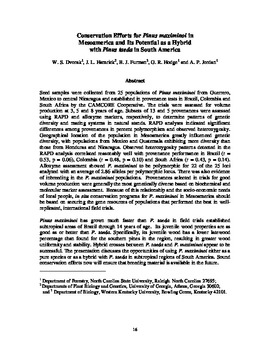| dc.contributor.author | Dvorak, W. S. | |
| dc.contributor.author | Hamrick, J. L. | |
| dc.contributor.author | Furman, B. J. | |
| dc.contributor.author | Hodge, G. R. | |
| dc.contributor.author | Jordan, A. P. | |
| dc.date.accessioned | 2016-04-25T19:35:53Z | |
| dc.date.available | 2016-04-25T19:35:53Z | |
| dc.date.issued | 2003 | |
| dc.identifier | oksd_sf27_p016.pdf | |
| dc.identifier.citation | Dvorak, W. S., Hamrick, J. L., Furman, B. J., Hodge, G. R., & Jordan, A. P. (2003). "Conservation Efforts for Pinus maximinoi in Mesoamerica and Its Potential as a Hybrid with Pinus taeda in South America." In 27th Southern Forest Tree Improvement Conference, Stillwater, OK | |
| dc.identifier.uri | https://hdl.handle.net/11244/33652 | |
| dc.description.abstract | Seed samples were collected from 25 populations of Pinus maximinoi from Guerrero, Mexico to central Nicaragua and established in provenance tests in Brazil, Colombia and South Africa by the CAMCORE Cooperative. The trials were assessed for volume production at 3, 5 and 8 years of age. Subsets of 13 and 5 provenances were assessed using RAPD and allozyme markers, respectively, to determine patterns of genetic diversity and mating systems in natural stands. RAPD analyses indicated significant differences among provenances in percent polymorphism and observed heterozygosity. Geographical location of the population in Mesoamerica greatly influenced genetic diversity, with populations from Mexico and Guatemala exhibiting more diversity than those from Honduras and Nicaragua. Observed heterozygosity patterns detected in the RAPD analysis correlated reasonably well with provenance performance in Brazil (r = 0.53, p = 0.06), Colombia (r = 0.48, p = 0.10) and South Africa (r = 0.43, p = 0.14). Allozyme assessment showed P. maximinoi to be polymorphic for 22 of the 25 loci analyzed with an average of 2.86 alleles per polymorphic locus. There was also evidence of inbreeding in the P. maximinoi populations. Provenances selected in trials for good volume production were generally the most genetically diverse based on biochemical and molecular marker assessment. Because of this relationship and the socio-economic needs of local people, in situ conservation programs for P. maximinoi in Mesoamerica should be based on securing the gene resources of populations that performed the best in well-replicated, international field trials. Pinus maximinoi has grown much faster than P. taeda in field trials established subtropical areas of Brazil through 14 years of age. Its juvenile wood properties are as good as or better than P. taeda. Specifically, its juvenile wood has a lower latewood percentage than found for the southern pines in the region, resulting in greater wood uniformity and stability. Hybrid crosses between P. taeda and P. maximinoi appear to be successful. The presentation discusses the opportunities of using P. maximinoi either as a pure species or as a hybrid with P. taeda in subtropical regions of South America. Sound conservation efforts now will ensure that breeding material is available in the future. | |
| dc.format | application/pdf | |
| dc.language | en_US | |
| dc.relation.ispartofseries | Sponsored publication . . . of the Southern Forest Tree Improvement Committee ; no. 49 | |
| dc.rights | This paper is made available through open access and the auspices of the fair use doctrine for scholarly, educational and research purposes while recognizing the publisher already offers a free online version. The OSU Library�s intent is to offer access and preserve publications involving its faculty contributions. Contact the Digital Resources and Discovery Services at lib-dls@okstate.edu or 405-744-9161 for the permission policy on the use, reproduction or distribution of this material. | |
| dc.source | Proceedings of the 27th Southern Forest Tree Improvement Conference, volume 27, 2003. Editor, Craig R. McKinley. | |
| dc.title | Conservation Efforts for Pinus maximinoi in Mesoamerica and Its Potential as a Hybrid with Pinus taeda in South America | |
| dc.type | text | |
| osu.filename | oksd_sf27_p016.pdf | |
| dc.type.genre | Conference proceedings | |
| dc.description.scopeandcontents | Papers and abstracts from the 27th Southern Forest Tree Improvement Conference held at Oklahoma State University in Stillwater, Oklahoma on June 24-27, 2003. | |
